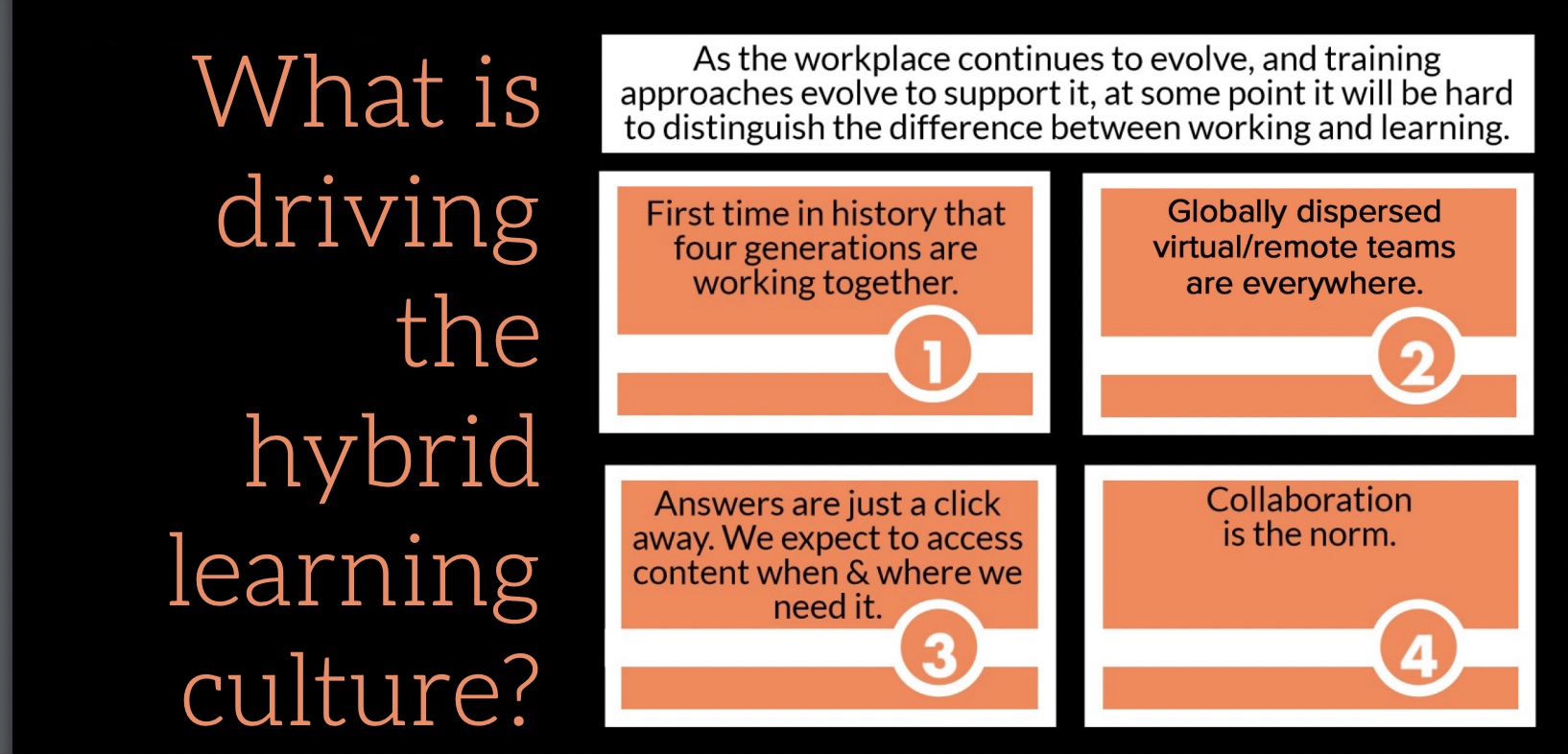6 min read
Cultivating a Strong Hybrid Work Culture with Collaborative Learning
 Jennifer Hofmann
:
Mar 5, 2024 9:00:33 AM
Jennifer Hofmann
:
Mar 5, 2024 9:00:33 AM

 The pandemic forced organizations worldwide to rethink traditional work models, leading to a significant shift toward hybrid and remote work arrangements. This transition was marked by the accelerated adoption of a “Virtual First” culture, where remote work became the default mode of operation. Companies embraced digital collaboration tools, cloud-based technologies, and virtual communication platforms to facilitate seamless remote work experiences. The “Virtual First” approach not only improved employee flexibility and work-life balance but also enabled organizations to tap into a global talent pool, breaking down geographical barriers. As a result, the hybrid work model has become the cornerstone of the post-pandemic workplace, offering a blend of in-person and remote work that enhances productivity, collaboration, and overall employee satisfaction.
The pandemic forced organizations worldwide to rethink traditional work models, leading to a significant shift toward hybrid and remote work arrangements. This transition was marked by the accelerated adoption of a “Virtual First” culture, where remote work became the default mode of operation. Companies embraced digital collaboration tools, cloud-based technologies, and virtual communication platforms to facilitate seamless remote work experiences. The “Virtual First” approach not only improved employee flexibility and work-life balance but also enabled organizations to tap into a global talent pool, breaking down geographical barriers. As a result, the hybrid work model has become the cornerstone of the post-pandemic workplace, offering a blend of in-person and remote work that enhances productivity, collaboration, and overall employee satisfaction.
Hybrid is Here to Stay
Most workers (and most corporate leadership) expect that hybrid work is here to stay. Most organizations have adopted company policies regarding remote and in-person work. Here are just a few of the recent statistics.
In 2024:
- Nationally, the percentage of fully remote workers and those working hybrid has largely stabilized since 2022.
- More than 25% of all labor hours are delivered remotely.
- More than 40% of the workforce operates in a hybrid work environment.
- Research shows that the optimal hybrid work schedule is between 2-3 remote days per week.
- The most successful organizations will be the ones that implement hybrid work effectively.
At InSync, we've been ahead of the curve, operating virtually long before it became the norm. One of our key focuses is ensuring our core values are not just theoretical but rather lived experiences for all our team members. Our main priority is fostering a culture of collaborative learning—acknowledging the learning challenges we've overcome and preparing for those that are yet to come. We have experienced both the highs and lows of new technologies and communication platforms and remain committed to finding the best solutions to keep our teams engaged and connected.
Hybrid Work Challenges
The hybrid workforce, while offering numerous benefits, also presents significant challenges. One of the most prominent issues is maintaining a sense of cohesion and inclusion among team members who are physically dispersed. Communication can be more challenging, leading to misunderstandings or missed messages. Additionally, managing different time zones and work schedules can be complicated. Ensuring that remote employees have the same opportunities for career advancement and professional development as their in-office counterparts is another challenge. Lastly, maintaining a healthy work-life balance can be more difficult for remote workers, as the boundaries between work and personal life can blur when working from home. Addressing these challenges requires thoughtful policies, robust communication strategies, hybrid-designed training, and a commitment to fostering a culture of inclusivity and work-life balance.
Hybrid Work Calls for Hybrid Learning
InSync’s recent research shows us that most organizations are not prepared to deliver training in a hybrid work environment. Training is typically designed only for remote OR in-person learning, not for the hybrid audience. Those learners who end up in the “other” audience are far less engaged with the content. Attrition rates of those in the “other” audience are also affected when training is designed without consideration of the needs of the “other” learners. However, InSync found that these challenges can be overcome when courses are specifically designed and delivered with both audiences in mind.
Based on InSync's research findings, we now know that these challenges can be overcome and that there is a clear path forward to address these issues and enhance organizational hybrid culture with collaboration. This path involves instructional experiences that bridge the gap between remote and in-office team members. If hybrid training is delivered effectively, the outcomes are like any other well-designed training delivery.
So, how can we make hybrid work culture more collaborative and effective?
Actionable Strategies for Cultivating a Strong Hybrid Company Culture
-
Focus on Inclusion and Communication
Improving inclusion and communication in the hybrid workplace is key for fostering a positive and productive work environment. To achieve this improvement, companies must prioritize creating a culture of inclusivity that values and respects diverse perspectives and experiences. This can be achieved through regular training and education on topics such as unconscious bias, cultural competency, and effective communication. Additionally, companies should implement collaborative technology solutions, such as Microsoft Teams or Slack, that facilitate seamless communication and collaboration among remote and in-person team members. By actively promoting inclusion and open communication, companies can create a more equitable and supportive workplace where all employees feel valued and heard.
L&D can offer training and workshops on effective communication, conflict resolution, and inclusive leadership. Doing so can help individuals understand the value of diverse perspectives and learn to communicate effectively in a hybrid work environment.
-
Tools to Support Collaboration
To support collaboration, L&D can provide training on how to use various tools and platforms that facilitate synchronous and asynchronous, as well as formal and informal, communication. This training could include programming on how to use project management tools, virtual meeting platforms, or social media platforms for informal communication. Better collaboration produces better outcomes and supports a robust company culture.
-
Robust Learning and Development Strategy
By incorporating collaborative learning activities such as group projects, peer reviews, or problem-solving tasks into the L&D strategy, companies can foster a culture of continuous learning and collaboration. L&D can also offer personalized learning paths and microlearning opportunities that cater to individual needs while promoting collaboration.
-
Best Practices for Hybrid Team Collaboration
L&D can organize workshops and seminars to share best practices for hybrid team collaboration. These could cover topics like setting clear expectations, promoting transparency, and using collaborative tools effectively. Case studies and role-playing scenarios can be used to provide practical examples.
-
Flexibility in Learning Opportunities
Flexibility is crucial in a hybrid work model. L&D can support this trait by offering flexible learning opportunities that employees can access at their own pace and from any location. Options could include online courses, webinars, or self-paced learning modules.
Remember, the goal of L&D in a hybrid work environment should be to equip employees with the skills they need to navigate the challenges of remote and in-office work, while fostering a culture of continuous learning and collaboration.
From Storming to Performing—Enhancing Performance for Hybrid/Virtual Teams
In the hybrid work environment, our team development models also need to evolve. Every time a new employee or team member is onboarded, team dynamics change. Teams need to be nurtured so that no one feels isolated in a virtual world. But how do managers and leaders evolve their existing skills to support this modern way of working? One proven approach: adapt an existing model based on our understanding of successful remote teams. One such model is the Tuckman Model, explained in four stages below:
Stage 1: Forming
During the Forming stage, the team is still developing. Team members are highly dependent on the leader for guidance and direction. There’s little agreement on each team aim, and members are still looking to the leader. There’s little trust between members, no norms have been developed, and roles and responsibilities are unclear.
Support the Forming stage by allowing time for team bonding, acknowledging that this process takes longer for virtual teams, and providing direction and purpose to your team. Find creative ways to connect, using messaging apps, virtual water coolers, mentors, and team celebrations.
Stage 2: Storming
During the Storming stage, we’ve already developed articulated roles and responsibilities. Team members have agendas and are working out boundaries and team mission. Because trust isn’t fully established, there are still some problems with problem solving.
Leaders need to be aware that at this stage, sub-groups can develop in your team. The team may be distracted by relationships and emotional issues (even more so today). Furthermore, your team members may be performing at different levels.
Guide your team through the Storming stage by
- increasing skill-building opportunities for your team,
- requesting and accepting feedback,
- defining rules of engagement, and
- establishing a supportive work environment.
Stage 3: Norming
In the Norming stage, we start to see consensus forming. There’s agreement on the team, and responsibilities are clear and accepted. People are making decisions by consensus and delegating because there’s commitment and unity.
As leaders, we shift from commanding our team to facilitating and enabling our team’s success. A habitual, short team morning session should occur where any challenges or roadblocks are discussed (like a standup session in agile development). Encourage Norming by putting things in writing. Talk about the norms so that everyone knows what they’re doing and how things work on this team. Remember: norms are not obvious unless they are documented and agreed upon.
Stage 4: Performing
When teams reach the Performing stage, they have a high degree of autonomy. Yes, disagreements will occur, but they are resolved with trust and positivity. Team members look out for, and after, each other.
In this stage, leaders now delegate tasks and work on encouraging the professional development of our direct reports. We also fend off distractions or disruptions from outside the team, including organizational politics. With virtual teams, we need to remember that it’s easy to slip out of this stage and revert to earlier modes of operating. We can take things out of context or struggle with communication. With awareness and constant work, we can maintain the Performing stage on our global virtual teams.
In the ongoing evolution of global hybrid work it’s imperative for organizations to adopt effective hybrid learning strategies from the outset. The hybrid work model is the cornerstone of the post-pandemic workplace, offering a blend of in-person and remote work that can enhance productivity, collaboration, and overall employee satisfaction.
Our research shows that there is a clear path forward to address the many challenges of hybrid work and to enhance organizational hybrid culture with collaboration. The path forward involves instructional experiences that bridge the gap between remote and in-office team members. If hybrid training is designed from the outset and delivered effectively, the outcomes for team members are as good as or better than any well-designed training delivery.
For more information about how to succeed in cultivating a strong hybrid work culture and to download our latest research report, visit https://www.insynctraining.com/hybrid-research.

Infographic - What is Driving the Hybrid Learning Culture?
Today's hybrid workforce is more global, virtual, and mobile than ever before with a modern learning culture that is not only just about technology –...


